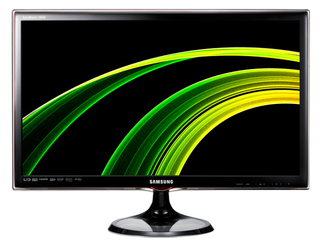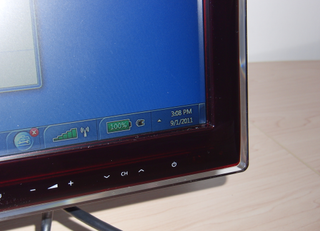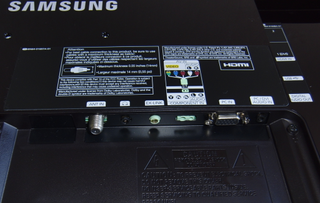24" LCD Round-Up: Acer S242HL, Dell U2412M, And Samsung T24A550
Samsung SyncMaster T24A550/T24A350

Samsung's SyncMaster T24A550 is the more expensive of the two 24" TN-based LCDs in our round-up. You wind up paying a price premium because this is a multifunction device with a built-in TV tuner. However, a relatively small screen size necessitates using this display from the distances typical of a PC (certainly not from 10 feet away on the couch). Viewing options are even more limited in light of the comparatively poor viewing angles inherent to TN-based panels. This makes the T24A550 a PC monitor that you can use to watch TV on, rather than a product that performs both functions with equal dexterity.

Samsung offers two multifunction monitor/TVs with a 24" screen size: T24A550 and T24A350. The difference between the two is very subtle; the T24A550 is a part of Samsung's Class 550 product line, while the T24A350 hails from Class 350. Physically, there's almost no difference aside from a translucent base stand. So, consider the two models effectively the same. Both boast the same reddish-black thin frame that Samsung dubs Touch Of Color (ToC) Rose Black.
The monitors in Samsung's Class 550 family without tuners include a built-in Pyrolectric Infrared Ray (PIR) sensor that automatically detects your presence in front of the screen, allowing it to automatically dim and power off when you get up. Once it detects a nearby viewer it powers back up, thereby keeping energy use as low as possible. Unfortunately, the line-up's multifunction displays (like the one we're testing), don't include it.

Connectivity is similar to other LED-backlit TVs. On the bottom recessed edge, you get coaxial input for cable or an antenna, a headphone output, Ex-Link for motorized wall mount control, a breakout connector for component/composite output, VGA for PC connectivity, and audio input.

On the right-hand side, you get two HDMI connections, a USB port, and an optical audio output. The USB port is interesting because it facilitates more than just the device's firmware. Samsung includes a feature called ConnectShare, which lets you plug in a USB mass storage device (formatted with FAT16, FAT32, or NTFS) and play videos or view pictures. The capability supports a wide variety of file formats from .AVI to .MKV and most major codecs, such as H.264, Xvid, DivX, MPEG-4, and motion JPEG. A complete list is available on page 123 and 124 of the user manual.
Although the T24A550 sports two 5 W speakers, they're not going to satisfy home theater buffs by any stretch of the imagination. Fortunately, if you're running an HDMI connection into the display, taking advantage of the S/PDIF output is an option. The built-in speakers offer a convenient way to minimize desktop clutter. To Samsung's credit, these speakers are decent, which isn't something we can say for every manufacturer that chooses to include speakers in their designs.

The OSD takes some getting used to because it almost monopolizes the whole screen. That makes perfect sense if you're watching TV, sitting a ways away from the monitor. Similar to older Samsung monitors, the menu is navigated using capacitive touch buttons on the lower edge of display. An included remote makes navigating the full-screen interface much more convenient from a distance.
Stay on the Cutting Edge
Join the experts who read Tom's Hardware for the inside track on enthusiast PC tech news — and have for over 25 years. We'll send breaking news and in-depth reviews of CPUs, GPUs, AI, maker hardware and more straight to your inbox.
Current page: Samsung SyncMaster T24A550/T24A350
Prev Page Dell UltraSharp U2412M Next Page Display Profile And Tilt-
fstrthnu I would have liked to see the older U2410 model here too, because that uses the "older" IPS technology and is apparently better enough for Dell to justify a $100 price premium over the U2412.Reply -
kyuuketsuki austinwillis81kinda confused why you would be comparinig an IPS to lcd but idkUh, why wouldn't they?Reply
I currently own an eIPS monitor, and will never go back to TN.
-
kyuuketsuki fstrthnuI would have liked to see the older U2410 model here too, because that uses the "older" IPS technology and is apparently better enough for Dell to justify a $100 price premium over the U2412.So… you didn't read the article? The whole point of eIPS is it's cheaper than other IPS panels, not that it's better.Reply -
flong Dell's U2412 is NOT the replacement for the U2410. Dell is going to continue to produce the U2410.Reply
Also the U2410 frequently goes on sale. I think it is a mistake to buy the U2412 when the U2410 is definitely superior to the U2412 in every benchmark.
Right now the most affordable HIPS monitors with the best performance are the Dell U2410 and the HP 2475W. I think that the HP 2475W has the edge slightly over the 2410. Asus also has put out a fairly good 24" HIPS monitor but the U2410 and the 2475W are better monitors per the professional reviews that I have read.
I own the HP 2475W and it does have beautiful picture. You have to go to NEC at twice the cost to improve on it.
-
kyuuketsuki God, really need an edit function here…Reply
Just reread your comment and my response was probably a little off-base. However, the U2412's predecessor should be better in every way (except possibly response time) since eIPS is meant to be more economical by trading off some of the quality of other IPS panels. -
flong KyuuketsukiGod, really need an edit function here…Just reread your comment and my response was probably a little off-base. However, the U2412's predecessor should be better in every way (except possibly response time) since eIPS is meant to be more economical by trading off some of the quality of other IPS panels.Reply
Hello :), I was not referring to you. The article's writer states that the U2412 is the successor of the U2410 when actually it is a more affordable IPS monitor for those with lower budgets. BTW, the article is very good; they just got this one thing wrong.
There is a huge difference between a picture quality HIPS monitor and a TN monitor. I have not seen an eIPS monitor but they seem to be pretty good also from the reviews that I have read. -
Hello! Could you guys review the LG IPS236v? It's also a cheap IPS panel, i don't know if it's the same technology used to make the U2412M. From my researches it dosen't seem to be sold in the US, but it already arrived in other countries (in Brazil it is being sold for about $300).Reply
PS.: Sorry if there's any mistake with my English. =) -
kevith "...since response time and input lag usually decreases with screen size. Why? Monitors with larger screens have higher pixel density, and as the number of pixels per inch (PPI) increases there are more pixels to refresh. Therefore, at 60 Hz, larger panels take longer to complete a complete screen refresh."Reply
Ehr, what...?
Most Popular

